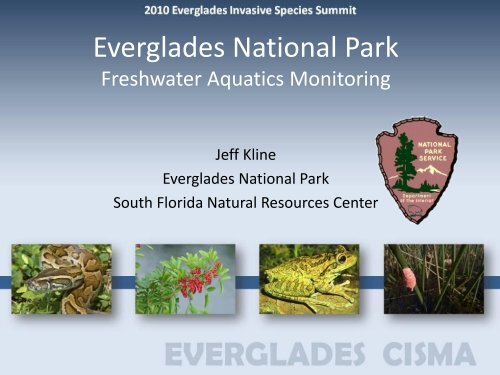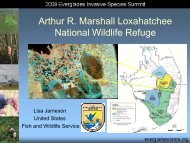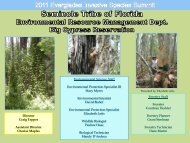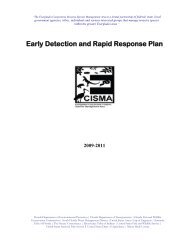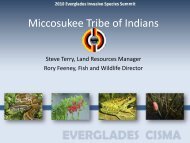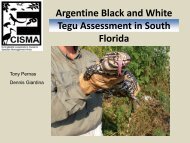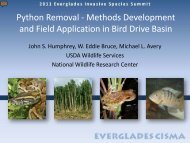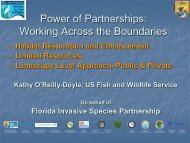Everglades National Park (Fish) - Everglades Cooperative Invasive ...
Everglades National Park (Fish) - Everglades Cooperative Invasive ...
Everglades National Park (Fish) - Everglades Cooperative Invasive ...
Create successful ePaper yourself
Turn your PDF publications into a flip-book with our unique Google optimized e-Paper software.
<strong>Everglades</strong> <strong>National</strong> <strong>Park</strong>Freshwater Aquatics MonitoringJeff Kline<strong>Everglades</strong> <strong>National</strong> <strong>Park</strong>South Florida Natural Resources Center
<strong>Invasive</strong> Species Programs6 L-31W canal stage• Generally species listsCanal bank elevation5Stage (ft)43• Pomacea insularum and P. diffusa-20052• Misc other aquatic invertebrates116Timeline of introduced fishes entering ENP14No. of introduced species121086421960-1980Mozambique tilapiaBlack acaraWalking catfishPike killifishBlue tilapiaPeacock bassSpotted tilapiaMayan cichlidOscarCanal overflow into marsh• 16 species of non-native fishJaguar guapote & African jewelfish1981 1983 1985 1987 1989 1991 1993 1995 1997 1999 2001 2003 2005 2007 2009YearSpotfinned spinyeel& Banded cichlidBrown hoploWater managementchange beginslate 1999Sailfin catfishAsian swamp eel
Priority Animal Species• Priority Animals– The most recent introductions– Most abundant– And those not in ENP yet!• Newly Detected Animal SpeciesImage by Windser Aguirre– Vermiculated Sailfin Catfish (Pterygoplichthys disjunctivus)
Fiscal Year Treatments: Cold weather 2010
• <strong>Fish</strong> monitoring– <strong>Park</strong>-wide sample-Annually– Monthly Rocky Glades– Long-term monitoring– Other monitoring efforts-Cooperators– Misc observationsMonitoring• Non-native apple snail– Pomacea insularum• Old Tamiami Canal surveyevery 8-10 days• May 2005-April 2010• May 2010-Once per month– P. diffusa at Frog City– Annual survey of border canals
Monitoring: Misc observations
Monitoring: Temperature stations
MonitoringWater temperature (oC)24 OT bottomP35 Surface22P36 bottom20NP206 bottomL31W bottom1816141210864201/1/20101/2/20101/3/20101/4/20101/5/20101/6/20101/7/20101/8/20101/9/2010Date1/10/20101/11/20101/12/20101/13/20101/14/20101/15/2010Peacock bass-15 o COscar-12.9 o CJaguar guapote-12.0 o CSpotted tilapia-11.2 o CWalking catfish-9.8 o CPike killifish-9.7 o CAfrican jewelfish-9.5 o CMayan cichlid-9.0 o CSailfin catfish-9.0 o CBlack acara-8.9 o CAsian swamp eel-8.0 o CBlue tilapia-6.2 o CBrown hoplo-5.7 o C
Monitoring: Misc observationsRotala rotundifolia“Uncertain if it will spreadfrom the canal to otherareas…but anywhere yousee Bacopa, you couldexpect it to establish”S-333L-29 CanalS-334
MonitoringIsland apple snailPomacea insularumS-333L-29 Canal2008S-334
MonitoringIsland apple snailPomacea insularumS-333L-29 Canal2009S-334
MonitoringIsland apple snailPomacea insularumS-333L-29 Canal2010S-334
S-333 L-29 CanalS-334P.insularum egg massesMarsh survey points (no eggs)CanalsENP boundary
Needs & Gaps• Prevention is key with fish and aquatic inverts!• Non-native species must be considered whendesigning water management changes– Non-native species are “bio-pollution”.– Study alternative ways of delivering water withoutdelivering non-native species.– Restore unnatural habitats• How do we work better with external managementagencies with different mandates and objectives tomeet our mandates?
Questions?


